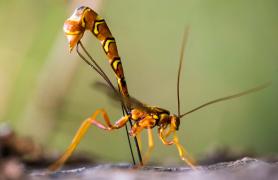There’s no better way to beat the heat than floating a canoe down a cool Ozark stream. Follow these tips, and you’ll be a paddling pro in no time.
Tip 1: Wear a Life Jacket
Even experienced paddlers flip a canoe every once in a while. Wear a life jacket at all times so you’re prepared for unplanned swims.
Tip 2: Hold Your Paddle Correctly
If you’re paddling on the right side of the canoe, your left hand should be on top of the grip, and your right hand should hold the middle of the shaft. If you’re paddling on the left side of the canoe, your right hand should be on top of the grip, and your left hand should hold the middle of the shaft.
Tip 3: Learn These Strokes
Different folks use different strokes, but these five will help you steer a canoe safely down a gently flowing stream.
Heads up! Canoe partners should paddle on opposite sides of the boat. If the person in the bow (front) paddles on the left, the person in the stern (back) should paddle on the right. If your arms get tired from paddling on one side, it’s OK to switch. Just give your partner a heads-up before you do.
Forward Stroke
Reach forward, place the paddle in the water, and pull straight back. When you pull the paddle from the water to start the next stroke, turn the blade so that it’s flat and skims forward over the water’s surface.
Back Stroke
This is the opposite of the forward stroke. Reach backward and push the paddle forward. This stroke is used to slow or stop the canoe from moving downstream.
J Stroke
Canoes tend to turn during a forward stroke. The J stroke is used to correct the turn and keep the canoe going straight. Begin a forward stroke. When the blade goes behind your body, twist the shaft of the paddle so that the blade turns outward and makes a J in the water
Draw Stroke
When done from the stern, a draw stroke turns the canoe away from the side you are paddling on. Reach out away from the canoe and place the blade in the water. Push with your grip hand while pulling with your shaft hand.
Pry Stroke
This is the opposite of the draw stroke. When done from the stern, it turns the canoe toward the side you’re paddling on. Place the blade straight down into the water directly beside the canoe. Pull with your grip hand while pushing with your shaft hand.
Tip 4: Read the River
Rocks, stumps, and other obstacles hide under the water’s surface, waiting for a chance to flip your canoe. Learn to read the river so you can avoid these hazards.
Upstream V When a rock or stump is submerged just below the surface, water flowing around it forms a V with the tip pointing upstream. If you see an upstream V, paddle around it!
Downstream V When water flows between two obstacles, it forms a V with the tip pointing downstream. Aim your canoe toward the center of a downstream V, and you’ll usually find smooth sailing.
Washboard Ripples These small, numerous waves indicate shallow water. They won’t cause you to flip, but you’ll often run aground and have to get out to pull your canoe.
Strainer The current cuts into the outer bends of rivers, washing away soil and causing trees to slide off the bank into the water. Avoid these trees! Their branches act like spaghetti strainers that can catch your canoe.
Horizon Line A horizontal line on the water’s surface indicates a steep, sudden drop in the river. The drop could be a fun-to-run 3-foot ledge or a dangerous, canoe-crumpling waterfall. The only safe way to find out is to beach your canoe and hike downstream for a look.
Also In This Issue


This Issue's Staff
Les Fortenberry
Karen Hudson
Angie Daly Morfeld
Noppadol Paothong
Marci Porter
Mark Raithel
Laura Scheuler
Matt Seek
David Stonner
Nichole LeClair Terrill
Stephanie Thurber
Cliff White






















